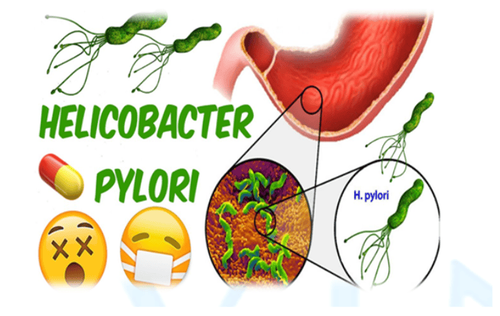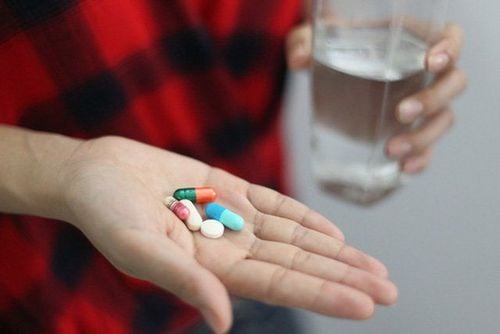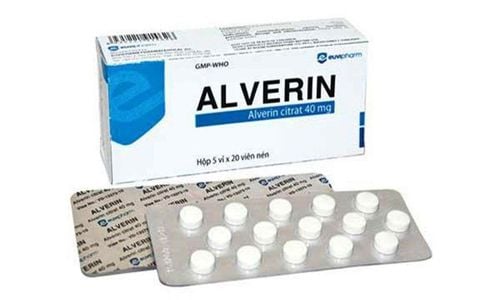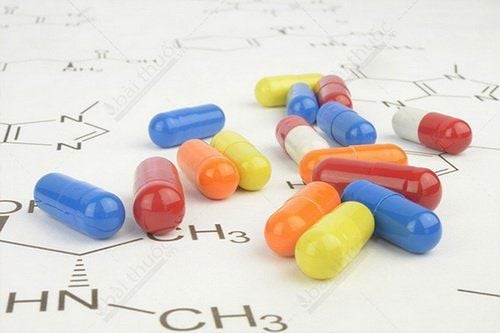This is an automatically translated article.
Gastroesophageal reflux disease (GERD) is a disease caused by gastric juice backing up into the esophagus causing symptoms and complications on the esophagus. Currently, the rate of people suffering from gastroesophageal reflux disease is increasing, leading to many difficulties in diagnosis and treatment. So, in clinical practice, are there any drugs to treat gastroesophageal reflux disease?
What is Gastroesophageal Reflux Disease?
1.1 Definition Gastroesophageal reflux is a normal physiological phenomenon, especially after a meal. However, when gastric juices back up into the esophagus excessively causing symptoms and complications on the esophagus, then gastroesophageal reflux disease (GERD) is formed.
Normally, the esophagus will be protected by the action of the upper and lower esophageal sphincters and the peristalsis of the esophagus, helping it to avoid contact with refluxed substances from the stomach. However, when these protective mechanisms are weakened, gastroesophageal reflux disease (GERD) begins to appear.
1.2 Causes Cases of weakness or abnormal opening and closing of the esophageal muscles are encountered in temporary dilation or decompression of the esophageal sphincter, weak esophageal peristalsis, and insufficient pushing of refluxed substances from the stomach down. or after surgery in the esophagus. Diaphragmatic hernia is also a fairly common cause. Conditions of increased acid secretion in the stomach, delayed gastric emptying, increased pressure in the stomach or abdomen, stagnation of food. H. pylori infection . Long-term anxiety, stress. Taking non-steroidal anti-inflammatory drugs (NSAIDs), Steroid anti-inflammatory drugs, Aspirin, anticholinergic drugs, Calcium channel blockers, Theophylline, Nitrin, some hormone-containing drugs (Progesterone), sedatives, antidepressants, Beta-blockers treatment of bronchial asthma... Using alcohol, carbonated drinks or tobacco. Lazy exercise. Conditions with increased intra-abdominal pressure such as overweight, obese patients or pregnant women. Family factor.
2. Diagnosis of gastroesophageal reflux disease
2.1. Clinical symptoms in the esophagus
Heartburn: A burning sensation that originates from behind the sternum spreading to the neck and throat, occurs more at night than during the day, increases when eating or lying down immediately after eating, pressing the abdomen, lying on your back or when bending over, changing positions...reduced after drinking milk or warm water. Ợ regurgitation: Feeling of gastric juices, food ... refluxing into the esophagus and going up the mouth, hypopharynx. Difficulty swallowing Sleep disturbance due to the influence of symptoms of digestive disorders. Extraesophageal symptoms
Cough with a chronic nature. Asthma . Laryngitis or recurrent pharyngitis. Aspiration pneumonia, lobar pneumonia. Tooth erosion. Chest pain after excluding cardiac causes. 2.2. Subclinical X-ray of gastroesophageal oesophagus with contrast to record lesions such as esophageal cancer, esophageal ulcers... Gastroduodenal endoscopy: Assess the condition of esophageal mucosa and serious complications in patients with suspected gastroesophageal reflux disease. Perform early gastroduodenal endoscopy in the following situations: There are alarm signs such as difficulty swallowing, painful swallowing, vomiting blood, weight loss, difficulty breathing at night. The diagnosis of the disease is unknown because the symptoms are atypical. Suspected complications. Symptoms did not subside and recur repeatedly despite treatment. Esophageal manometry (measurement of esophageal peristaltic pressure) and esophageal pH measurement for 24 hours are necessary tests before surgery is indicated. Clinically, these two tests are usually performed for research purposes only. Bernstein test. Esophageal biopsies or histopathology.
3. Treatment of gastroesophageal reflux disease
3.1. Non-drug treatments
Dietary changes
Maintain an appropriate weight. Limit fatty and greasy foods, sour dishes and fruits... Abstain from coffee, alcohol and carbonated drinks... Divide into many small meals, do not lie down. Immediately after eating, do not eat too much. Lifestyle changes
Elevate your head when lying down (10-15 cm) or use anti-reflux pillows when lying down to make the patient more comfortable. Avoid wearing clothes that are too tight. Limit smoking. Reduce anxiety and stress. 3.2. Gastroesophageal reflux what drugs? Gastroesophageal reflux what drugs? Clinically, there are many drugs for the treatment of gastroesophageal reflux disease with different mechanisms of action and usage. Patients and family members should consult a specialist before deciding to use any medication.
3.2.1. Proton pump inhibitors (PPIs) are the most powerful and most commonly used drugs that block gastric acid secretion. Proton pump inhibitors (PPIs) are indicated for the treatment of moderate to severe or complicated gastroesophageal reflux disease by inhibiting the activity of the enzyme H + K + ATPase, thereby inhibiting secretion of gastric acid.
Some Proton pump inhibitors (PPIs) are commonly used today such as:
Omeprazole: Standard oral dose of 20 mg/day. For refractory GERD, 20 mg orally twice a day. Pantoprazole: Standard oral dose of 40 mg/day. For refractory GERD, 40 mg/time x 2 times/day. Esomeprazole: Standard oral dose of 40 mg/day. For refractory GERD, 40 mg/time x 2 times/day. Rabeprazole: Standard oral dose of 20 mg/day. For refractory GERD, 20 mg orally twice a day. Lansoprazole: Standard oral dose of 30 mg/day. For refractory GERD, take 30 mg/time x 2 times/day. Dexlansoprazole: Standard oral dose of 60 mg/day. For refractory GERD, orally 60 mg/time x 2 times/day. The drug is usually taken about 30 minutes before eating to achieve the best treatment effect. Treatment usually lasts from 4 to 8 weeks, or can be up to 12 weeks.
3.2.3. Acid and Alginate Neutralizing Drugs Commonly used gastric acid neutralizing drugs are drugs containing aluminum salts (carbonate, hydroxide, phosphate) and magnesium salts (carbonate, hydroxide, trisilicate) such as Maalox, Gastropulgite, Alusi... this drug has side effects such as constipation or diarrhea...
Alginate is an active ingredient that helps to create a neutral plaque to prevent reflux or replace the gastric juice component that flows up the lower esophagus. The drug commonly used is Gaviscon.
The above drugs are usually used 1 to 3 hours after eating.
3.2.5. Histamine H2 receptor antagonists H2 receptor antagonists work to compete with the H2 receptors in parietal cells, reducing gastric acid secretion in the stomach, thereby helping to limit esophageal ulcers.
Some commonly used drugs such as Ranitidine , Zantac , Tagamet... Use a ruler for about 15 to 30 minutes.
Histamine H2 receptor antagonists have a faster duration of action than proton pump inhibitors (PPIs), but long-term use can cause side effects such as gynecomastia in men. ... Therefore, at present, H2 antihistamines are used less often than Proton pump inhibitors (PPIs).
3.2.4. Prokinetics: Prokinetics help increase acid excretion in the esophageal lumen, and at the same time enhance gastric emptying and increase peristalsis of the esophageal muscle. This class of drugs is often used in combination with proton pump inhibitors (PPIs) in the treatment of gastroesophageal reflux disease.
Metoclopramide: Take 10-15 mg x 4 times/day. Domperidone: Take 10 mg x 3 times/day. Baclofen: Take 10-20 mg x 2-3 times/day. 3.2.4. Antidepressants Antidepressants are used as a supportive measure in the treatment of gastroesophageal reflux disease, helping patients reduce anxiety, stress, stress... are contributing factors. disease formation.
Commonly used drugs such as: Imipramine , Nortriptyline , Trazodone , Sertraline ...
However, antidepressants should be used with caution in the treatment of gastroesophageal reflux disease, because of the side effects of these drugs. drugs in the gastrointestinal tract.
3.3. Surgical treatment of gastroesophageal reflux disease Surgical treatment (surgery) or endoscopic intervention is indicated when medical therapy fails or the patient does not want to take medication for a long time.
Current popular treatment methods such as:
Endoscopic suture of the esophageal sphincter. Nissen Plastic Surgery. Ligation of the esophageal sphincter with a magnetic device.
4. Complications of gastroesophageal reflux disease
Complications of gastroesophageal reflux disease may occur as follows:
Erosive esophagitis (EE). Barrett's esophagus. Esophageal stricture. Esophageal perforation and ulceration. Stomach cancer . Currently, gastroesophageal reflux disease is a very common gastrointestinal disease. Patients need to go to medical facilities immediately for examination and early detection of the disease, and at the same time consult a specialist to be able to use effective drugs to treat gastroesophageal reflux, in order to limit obtain complex intervention procedures and prevent complications of the disease.
Follow Vinmec International General Hospital website to get more health, nutrition and beauty information to protect the health of yourself and your loved ones in your family.
Please dial HOTLINE for more information or register for an appointment HERE. Download MyVinmec app to make appointments faster and to manage your bookings easily.













